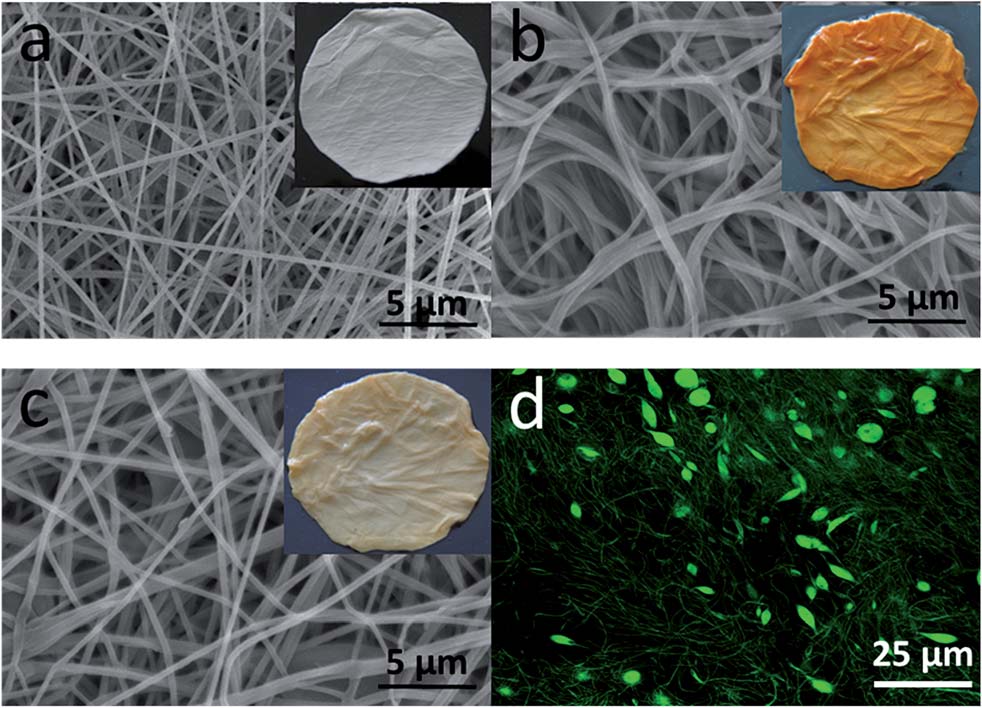Research
Research Mission:
The research conducted within The Laboratory of Soft Materials & Green Chemistry focuses on exploring bipolymeric structure and reactivity to expressly develop unique and “smart” materials, drug delivery vehicles, and self-healing/tissue engineering constructs.
AREAS OF RESEARCH:
1. Unique & Smart Materials
Bacterial Cellulose. The functionalization and assembly of macromolecular structures lies at the heart of simulating the chemistry of living systems (biomimicry). Within this discipline, the concept of inducing a specific responses based on an external trigger relies on a well defined structural assembly.
We have attempted, therefore, to control the chemistry and organization of biomaterials by taking advantage of living nanoreactors such as bacterial cellulose (BC). For example, we have been able to develop bio-fabricated graphene sheets as shown in the figure below (a: time lapsed photographs; b: cartoon representation of the reduction of GO to graphene, RGO). It was found that graphene oxide can be reduced under specific BC cultivation broth conditions to produce graphene clusters over a period of ~ one week.

The nanofibrils that are produced by the bacterial are extremely flexible in their overall capacity to house materials or perform unique chemistry. We currently are interested in modifying the bio-product characteristics in situ and following production through a series of green chemistries. Our current theme in this area is modifying the surface characteristics to introduce supersurface energies (hydrophilicity/oleophobicity) to address possible development of filtration systems.
Composite Biomaterials. SEM and digital photographs of PAN/O-MMT composite nanofibers before and after chemical modification: (a) PAN/O-MMT composite nanofibrous membrane; (b) PAN/O-MMT composite nanofibrous membrane after alkaline hydrolysis; (c) PAN/O-MMT composite nanofibrous membrane after carboxyl activation. (d) Confocal Laser Scanning Microscope (CLSM) photo-micrographs of PAN/O-MMT composite nanofibrous membranes after enzyme immobilization.

Drug Delivery
The opportunity to provide a drug delivery motif to biomolecular assemblies requires an understanding of the following criteria:
- Development of hydrogel, ionomers, or self-assembled polymeric systems in which a cargo is encased;
- Interaction and encapsulation phenomena associated with cargo and the host system;
- Triggered release by external stimuli that includes light, temperature, pH, ionicity, pressure, magnetism, current, etc.
In our laboratory we have attempted to provide solutions to the complexities of drug delivery phenomena by modulating and modifying various biopolymers. This hypothetical construct is based on the biocompatibility, biodegradability, and efficiency inherent in bio-based systems as opposed to petroleum- or artificial systems. For example, we have attempted to exploit the potential of fructan (“inulin”-like)-based coacervates for the delivery of ibuprofen cargos.

3. Self-Healing and Tissue Engineering Scaffolds
Our current attention has been focused on utilizing cellulosic materials for tissue-engineering applications because its native chemical structure is quite similar to that of the fibrous collagen molecule which provides the requisite tensile strength to AC and, quite feasibly, can be used as collagen-mimicking substrate (Bäckdahl et al., 2008; Bhosale and Richardson, 2008). Various studies as early as 2000 have been executed in which cellulose for cartilage TE has been exploited (Ko and Iwata, 2001). Within a short time, cellulosic materials were modified chemically and physically to meet specific scaffolding (biochemical and biophysical) requirements. Our current overview focuses on the science and engineering of cellulosic materials for fabricating scaffolds such as cellulose fabrics, sponges, hydrogels, composite materials, and the unique nanofibrous material known as bacterial cellulose (BC).
Fabrication of cellulosic composite scaffolds for cartilage tissue engineering. Available from: https://www.researchgate.net/publication/300115693_Fabrication_of_cellulosic_composite_scaffolds_for_cartilage_tissue_engineering [accessed Jul 17, 2016].